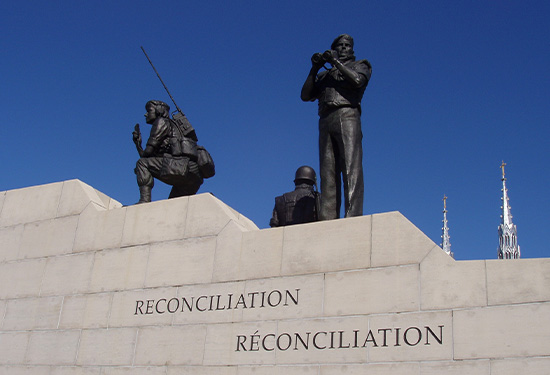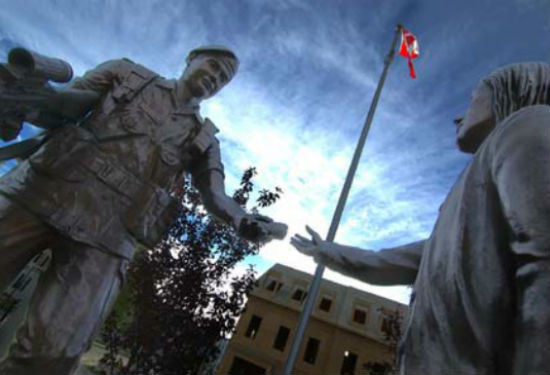Order of events
1956
Egypt nationalizes the Suez Canal. Then Israel invades Egypt, and French and British troops land in the Canal zone.
1956
The United Nations Emergency Force is established in Egypt.
1956
British and French troops withdraw from the Suez Canal zone.
1957
Israeli troops withdraw from the Sinai Peninsula in Egypt.
1957
Lester B. Pearson awarded the 1957 Nobel Peace Prize for his work to create the United Nations peacekeeping mission.
1967
Egypt demands the removal of peacekeepers in the country in the lead-up to the Six-Day War.
1973
Egypt and Syria attack Israeli forces, which begins the Yom Kippur War.
1973-1979
The United Nations Emergency Force-2 maintains peace in the region until Camp David Accords ended the UN mission.
1986-present
Canadian Armed Forces members return to Egypt as part of the Multinational Forces and Observer peace mission.
Classroom materials
Over the last 70 years, thousands of Canadians have participated in peace efforts in Egypt. Their service has touched the lives of many people in a land often rocked by strife and conflict.
Egypt made headlines around the world during the Suez Crisis in 1956. In response to this threat to world peace, Prime Minister Lester B. Pearson suggested the idea of a peacekeeping force. As a result, the United Nations (UN) initiated its first large-scale peacekeeping mission.
A large contingent of Canadian Armed Forces members served as peacekeepers in the land of the Nile. Between 1956-1967, and again from 1973-1979, Canadians were a familiar presence among the UN troops there. Since 1986, Canadian peacekeepers have served with the Multinational Force and Observers peace mission in Egypt.
In all its missions to Egypt, Canada's main contribution was logistical in nature. This included transportation, communication, supply and health support for the UN forces.
At times, the total size of the UN peace forces in Egypt was upward of 7,000 troops drawn from 20 countries.
Egypt
Egypt is a desert nation in the Middle East. It forms the only land link between the continents of Africa and Asia. Egypt is home to the Suez Canal, a waterway that allows ship traffic between the Mediterranean Sea and the Red Sea.
Tensions rise
After the Second World War, Egypt gained full independence. But the Suez Canal remained under the control of British and French interests. This situation paved the way for increasing tensions in the region.
In 1956, Egypt seized control of the waterway. France, the United Kingdom and Israel banded together in response. Later that year, Israel invaded Egypt and pushed on toward the Suez Canal. The British and French then landed troops of their own along the Canal zone to secure it.

The Suez Canal as seen from HMCS Magnificent helicopter, January 1957. Photo: Library and Archives Canada
The world responds
The United Nations
This invasion by France, the United Kingdom and Israel created great concerns in the international community. The United Nations knew they had to intervene and called for an emergency session. The UN urged for an immediate cease-fire and withdrawal of foreign forces from Egypt.
A Canadian suggestion
Lester B. Pearson, Canada’s Secretary of State of External Affairs, suggested creating a multinational armed force. These troops would have the resources to help restore peace in Egypt. They would also help defuse the larger political tensions and prevent a major international confrontation from happening.
The United Nations members agreed. Another Canadian, Major-General E.L.M. “Tommy” Burns, commanded the United Nations Emergency Force that monitored and enforced this plan. The countries involved in the conflict accepted these terms.
Canada and the peacekeeping era
This new peacekeeping force deployed to Egypt—and the modern era of international peacekeeping was born! Lester B. Pearson received the 1957 Nobel Peace Prize for his historic suggestion and his work toward setting up this first major peacekeeping mission.
Blue berets
Canada served in this early UN peacekeeping mission. Canadian and British soldiers—who were one of the combatants—had similar uniforms and weapons. The Canadian peacekeepers needed to distinguish themselves from the British. As a result, the United Nations troops wore blue headgear to easily identify them as peacekeepers. Blue berets and helmets are still well-known international symbols of peace.

Three Canadian peacekeepers wearing their blue United Nations caps during a patrol in Egypt in the 1960s. Photo: Department of National Defence
Post-Suez crisis
At first, the UN initiative was a success. Britain and France withdrew their troops by the end of 1956. Israel followed suit by March 1957. UN observers remained along the border area between Israel and Egypt for more than a decade.
Unfortunately, tensions heightened again in 1967 in the lead-up to the Six-Day War. Egypt demanded the departure of the peace forces stationed on their soil.
Following the Yom Kippur War of 1973, the UN was called in again to help maintain the peace. The UN responded and supported peace efforts until the signing of the Camp David Accords in 1978. This deal created the framework for a lasting peace agreement between Egypt and Israel. This UN mission came to an end in 1979.
Operation CALUMET
In 1982, the independent Multinational Force and Observers peacekeeping operation was established in the Sinai Peninsula. Four years later, the Canadian Armed Forces joined the operation and returned to Egypt with Operation CALUMET. This continues today to support the terms of the peace treaty.

Master Corporal Bonnie Leung, Canadian Contingent member of Multinational Force and Observers, acts as a protester during crowd control exercises at North Camp in Sinai, Egypt. 9 April 2013 Photo: Combat Camera. As the Multinational Force and Observers mission is not a UN operation, these peacekeepers wear orange caps and helmets rather than blue headgear.

Canadian Armed Forces members practice gun safety before firing on the range. Operation CALUMET, Sinai, Egypt. April 2013. Photo by: Canadian Armed Forces
Diplomacy
For our Canadian Armed Forces members, there is more to peace efforts than meets the eye. For example, once active fighting in Egypt ended, Israelis and Egyptians had to co-exist under terms of the cease-fire. After the Yom Kippur War in 1973, the local UN mission commanders, which included Canadian officers, acted as intermediaries in many delicate negotiations. Much of their job was diplomatic. At the time, they had to broker countless, delicate agreements involving sensitive matters. These included prisoner exchanges and the recovery of war dead.
Peace support
Peacekeeping has changed since Canada’s initial participation in Egypt. As dozens of missions have followed since, the concept of peacekeeping has evolved. It has become a peace support force that manages military conflict and civil unrest. Peace support is a sophisticated, complex and often dangerous process.
Sacrifice
More than 150 UN troops died in their peace efforts for Egypt, including more than 50 Canadians. This was the largest loss of life in any single Canadian peace effort.
In Gaza, there is a cemetery of Commonwealth troops who died during the First World War. One corner of this cemetery is also home to the graves of 22 Canadians who died during peace efforts in Egypt in the 1950s and 1960s. They lay alongside those who also served their countries—and the world—during the First World War.
They died as a result of many perils such as ambushes, land mine explosions and vehicle accidents. These represent only some of the dangers faced during peace missions. Even today, the grim legacy of war lives on in Egypt. The presence of land mines is an ongoing danger for its citizens and multinational troops maintaining the peace.
- Date modified:


























